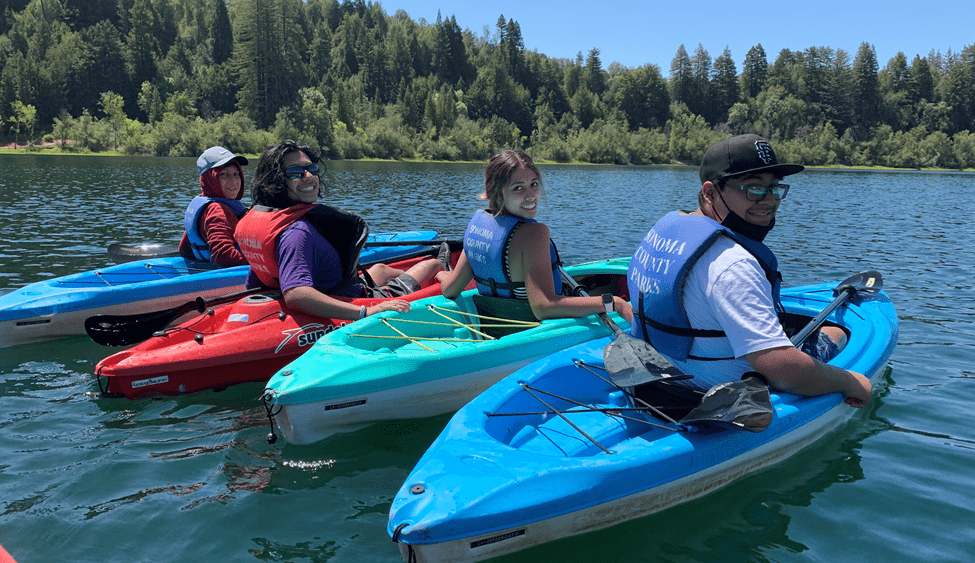
wildfire
The County of Sonoma recognizes the importance of intentional and coordinated efforts to prepare and help mitigate the effects of wildfire. In response to the critical need throughout the region, several County departments have received funding to do essential work to protect the community.
Permit Sonoma
Permit Sonoma is actively working toward wildfire risk reduction across the County. The department has received funding from FEMA’s Hazard Mitigation Grant Program to launch a first-of-its kind project designed to help protect homes in high-risk areas of the County. The Wildfire Adapted Sonoma County Program includes assessing more than 5,000 properties, providing residents with information about how to prepare their homes, and will provide limited cost-share incentives to eligible properties to make changes. The program also includes plans for robust community engagement and education. Learn more about the Wildfire Adapted project and eligible properties at SoCoAdapts.org.
This program launch is in tandem with development of the Sonoma County Multi-Jurisdictional Hazard Mitigation Plan and an update of the 2016 Sonoma County Community Wildfire Protection Plan. Both plans will incorporate stakeholder input, risk assessment modeling, and science-based action plans, as well as measures to create communities that are resilient to not only wildfire but to a multitude of other natural hazards.
Department of Emergency Management
The County of Sonoma Department of Emergency Management continues to expand and improve alert and warning systems as well as community preparedness. Videos, guides and planning resources are available on socoemergency.org, the County’s emergency readiness, response and recovery website. DEM continues to coordinate with and support neighborhood groups in their preparedness efforts including FireSafe Councils, COPE (Citizens Organized to Prepare for Emergencies) and Map Your Neighborhood. Virtual preparedness workshops are planned for the coming months, with a focus on building a Go-Bag, making an emergency plan and guiding residents on how to stay informed during emergencies.
Through recent grant funding, artificial intelligence technology has been incorporated into the existing ALERTWildfire camera-monitoring system throughout the County. The experimental technology will notify emergency staff when fires are spotted through the camera system, regardless of whether anybody is watching. Grant funds will be used to install six additional cameras to the existing system and reinforce critical communication towers with fire-resilient measures.
In the coming months, DEM is working to conduct evacuation drills with two communities in unincorporated Sonoma County: Fitch Mountain and Camp Meeker/Occidental. The drills will engage residents during the planning, execution and post-exercise review process. The purpose of the drills is to ensure that residents know the best routes to use during an evacuation and test alerting systems to better understand their capabilities in rural, rugged-terrain regions.
DEM has recently completed a County Alert & Warning Plan, which was reviewed by the Board of Supervisors on April 13. DEM is supporting the Sonoma County Sheriff’s Office in completing a countywide map of evacuation zones, the map is a key component of a County Evacuation Plan, which will be presented to the Board of Supervisors in August.
Starting in May, DEM will be distributing “Evac Packs” via community groups to residents. The durable envelopes are designed to be mounted in a readily-accessible location. They contain information on when to evacuate and what to take as well as other tools.
Department of Transportation and Public Works
The County of Sonoma Department of Transportation and Public Works continues its commitment to reducing the loss of life and property from natural disasters through multiple measures and to expanding resilience to wildfires, seismic events, floods and other hazards.
In 2019, TPW expanded its vegetation management program to include clearing within four feet of the edge of public roadways, including swales and culverts, and 14 feet above roads within the public right-of-way. The enhanced policy was developed in response to an increased awareness among officials and communities about best practices for the reduction of fire fuel and flood waste following successive wildfire and flood disasters.
The enhanced vegetation management is made possible in part through strategic partnerships with Youth Ecology Corps, North Sonoma County Fire, Sonoma Water, City of Healdsburg Fire Department, and Conservation Corps North Bay. These groups provide resources, expertise, and community-based support for vegetation management from young adults seeking professional training, work experience, and civil service opportunities. The new practice also complements TPW efforts already underway, including an ongoing hazard tree removal program to remove fire-damaged trees that pose a risk to public safety and roadways within burned areas.
Recently, the Department of Transportation and Public Works received $2.1 million for a project with the Sonoma County Water Agency to reduce flood risks and protect ecosystems along Green Valley Creek, install backup power generators at Charles M. Schulz – Sonoma County Airport, the Santa Rosa and Forestville Road Yards, and implement a fire fuel management and public education program in west Sonoma County.
The Roadway Safety, Fuels Reduction, Community Chipper and Engagement Project is a fire prevention and public education program designed to proactively address fire fuel management in rural west Sonoma County. Because individual property owners are responsible for the removal and maintenance of fire-damaged trees and fuels within private property lines, the additional public outreach and education, homeowner assessments, chipper coordination, and reporting services will help meet the County’s goal of fire fuel removal along public roads, safe ingress and egress of emergency vehicles, and increased community awareness of fuel reduction best practices.
Additional projects and programs anticipated as part of TPW’s efforts:
• Russian River Flood Management and Fisheries Habitat Enhancement Planning • Geyserville Drainage Feasibility Plan • Bank Stabilization to Save River Road in Geyserville • Cavedale & Trinity Roads Fuels Reduction
• Rio Nido Culvert Installations to Reduce Flooding • Advance Assistance for Villa Grande Flood Mitigation Plan • Annapolis Road Yard Generator • Forestville Road Yard Generator • Grove Street and Occidental Road Fire Fuel
Reduction Projects
For more information on how to prepare for wildfires and other natural disasters visit: SoCoEmergency.org/prepare



